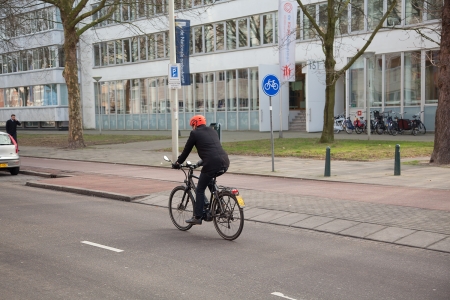As with crashes involving conventional bicycles, a combination of factors leads to a road crash involving pedelecs or speed pedelecs (see SWOV fact sheet Cyclists). In addition, pedelecs and speed pedelecs have a number of characteristics which differ from conventional bicycle characteristics, and which seem to contribute to crash occurrence: higher speed (due to pedal assistance) and increased weight. Moreover, the age of the pedelec riders comes into play: most of them are over-65s.
Speed pedelecs crash types
The results of in-depth research into speed pedelec crashes shows that five crash types can be distinguished [29] :
- Type 1: Speed pedelec rider loses control due to slippery, soiled or damaged road surface. For this type of crash, the condition of the road surface is a main factor.
- Type 2: Speed pedelec rider collides with an obstacle. Several factors are at play, but mostly factors involving road users themselves.
- Type 3: Speed pedelec rider takes risks causing a collision with another road user or causing a fall due to a required swerving manoeuvre. Important factors are a too high speed unsuitable to the circumstances, but also other behaviour, and poor visibility of other traffic, e.g. due to trees/shrubs, other road users, or a curve.
- Type 4: Other road user takes risks causing a collision with the speed pedelec rider or a fall of the speed pedelec rider. Often the behaviour of the other road users is the crash cause, for example when they use the wrong side of the road or when they carry out a strange, or unexpected manoeuvre.
- Type 5: Speed pedelec rider collides with another road user at a confusing or complex intersection. Once again, the behaviour of the other road user is an important factor, but also intersection characteristics such as a traffic light which is not conflict-free or unclear priority regulations.
In a recent survey [18] of the 17 speed pedelec crashes studied slightly less than half proved to be a single-vehicle crash (mostly slipping), over a third appeared to be a crash with an object (curb, animal), and almost a quarter a crash with another road user (cyclist or motor vehicle).
Speed of pedelecs and speed pedelecs
Due to pedal assistance, pedelecs and speed pedelecs can, with the same effort, attain higher speeds than conventional bicycles. Also in practice, pedelec riders go faster than conventional cyclists (see the question How fast do pedelec and speed pedelec riders cycle?). This applies even more to speed pedelecs [30]. Speed is a major factor in the occurrence and outcome of road crashes: the higher the speed, the more crashes and the more severe the injuries (see SWOV fact sheet Speed and speed management). In theory, this also goes for bicycles (with and without pedal assistance) but, as far as we know, there are no objective, empirical data to either support or refute this.
Both the Swiss survey among pedelec and speed pedelec riders [28], and the in-depth study of speed pedelec crashes [29] showed that speed was an important factor contributing to their crashes. This did not concern absolute speed, but a speed that was too high under the prevailing conditions.
Weight of pedelecs and speed pedelecs
Pedelecs and speed pedelecs are much heavier than conventional bicycles. This affects riding characteristics, particularly when mounting, dismounting and balancing at low speeds [31]. In a Swiss survey [28] among pedelec and speed pedelec riders, one third of the respondents (34%) indicated that a lack of balance, for example after a swerving manoeuvre, had contributed to their single-vehicle crash. Most (82%) said this would also have happened if they had used a conventional bicycle, but the 18% that did designate the bicycle characteristics as a crash factor often mentioned weight and balance. In a Danish survey of crash involvement of pedelec riders, one in ten respondents (10.2%) mentioned the weight and/or balance of their pedelec [32].
The over-65s as pedelec riders
At present, pedelecs are particularly popular among seniors aged 65 or over (see the question How many pedelecs and speed pedelecs are currently used and by whom? Although the stereotypical senior citizen does not exist, due to large individual differences in fitness and impairments, the average risk of serious injuries is higher for over-65s than for younger cyclists, even when crash impact is equal. Due to age-impaired cognitive skills and motor skills, the over-65s and over-75s also run a higher risk of crash involvement. In-depth research into bicycle crashes of cyclists aged 50 or over showed that older cyclists (over-70s) relatively more often fall when mounting and dismounting [33]. For more information, see SWOV fact sheet Older road users. The fact that a large number of pedelec riders are older than 65, probably affects the crash and injury risk of the pedelec rider group as a whole.
